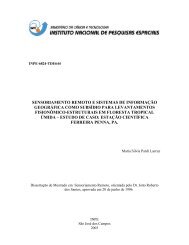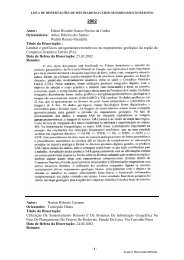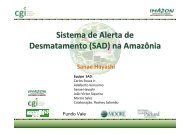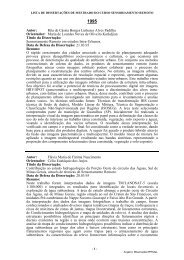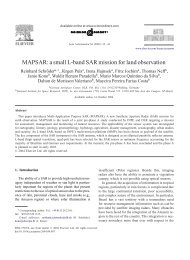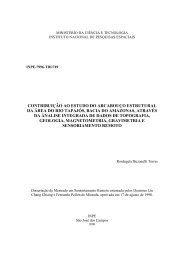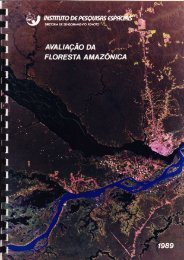Documento completo - OBT - Inpe
Documento completo - OBT - Inpe
Documento completo - OBT - Inpe
You also want an ePaper? Increase the reach of your titles
YUMPU automatically turns print PDFs into web optimized ePapers that Google loves.
USE OF IKONOS II DATA FOR URBAN ANALYSIS: OPERATIONAL TESTS IN<br />
EASTERN SÃO PAULO CITY<br />
ABSTRACT<br />
This work presents an application methodology of Remote Sensing and Geographic<br />
Information Systems (GIS) aiming to analyze the contribution of high resolution image<br />
data from IKONOS II satellite, for the implementation of a highway as well as for urban<br />
development. The area under study is located at the eastern section of São Paulo<br />
Metropolitan Region, where the eastern segment of the ring road called “Rodoanel<br />
Metropolitano de São Paulo” will be implanted. In order to use Remote Sensing and GIS<br />
techniques properly, the fundamentals of the methodology were presented, explaining why<br />
they were used. In this study thematic data of Geology, Geomorphology and Topography<br />
were used, showing the potential of these information in a GIS. The following image data<br />
were used: Landsat 7 ETM+ bands 1,4, and 7, SPOT 4 panchromatic band, IKONOS II<br />
multispectral bands 1,2 and 3 and the panchromatic band. Several experiments were done<br />
with these data, integrating them through a transformation of the color space. Using relief<br />
information associated to IKONOS II data, an animation was done, demonstrating the local<br />
topography in 3D. The information on land use/land cover were obtained through an image<br />
from the transformation of the color space from IKONOS II, followed by a thematic<br />
classification using the new application software eCognition. This package uses a new<br />
concept for image analysis: it uses the object oriented classification. The results of this<br />
study showed that the integration of the panchromatic IKONOS II image with the<br />
multispectral Landsat 7 ETM+ scene, through the transformation in the color space, did not<br />
present good results. Nevertheless, the object oriented classification allows new<br />
alternatives, such as: discrimination of classes to evaluate spectral bands separately by size,<br />
form, texture and number of borders of a thematic class. With this procedure, there is a<br />
higher interaction between the classifier and the scene to be classified.



